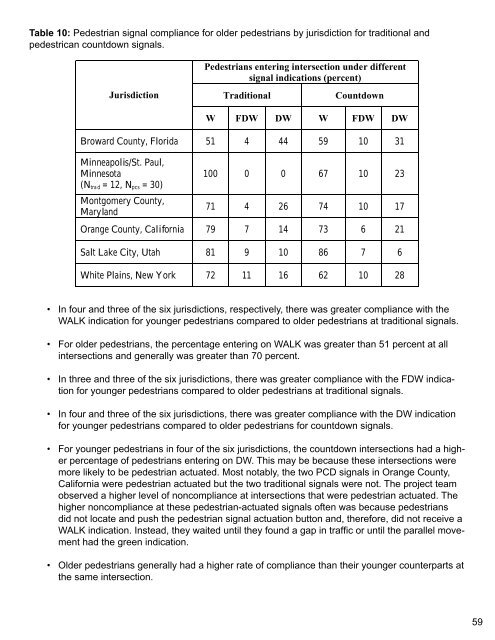Pedestrian Signal Safety - AAA Foundation for Traffic Safety
Pedestrian Signal Safety - AAA Foundation for Traffic Safety
Pedestrian Signal Safety - AAA Foundation for Traffic Safety
Create successful ePaper yourself
Turn your PDF publications into a flip-book with our unique Google optimized e-Paper software.
Table 10: <strong>Pedestrian</strong> signal compliance <strong>for</strong> older pedestrians by jurisdiction <strong>for</strong> traditional and<br />
pedestrican countdown signals.<br />
Jurisdiction<br />
<strong>Pedestrian</strong>s entering intersection under different<br />
signal indications (percent)<br />
Traditional Countdown<br />
W FDW DW W FDW DW<br />
Broward County, Florida 51 4 44 59 10 31<br />
Minneapolis/St. Paul,<br />
Minnesota<br />
(Ntra d = 12, Npcs = 30)<br />
Montgomery County,<br />
Maryland<br />
100 0 0 67 10 23<br />
71 4 26 74 10 17<br />
Orange County, Cali<strong>for</strong>nia 79 7 14 73 6 21<br />
Salt Lake City, Utah 81 9 10 86 7 6<br />
White Plains, New York 72 11 16 62 10 28<br />
• In four and three of the six jurisdictions, respectively, there was greater compliance with the<br />
WALK indication <strong>for</strong> younger pedestrians compared to older pedestrians at traditional signals.<br />
• For older pedestrians, the percentage entering on WALK was greater than 51 percent at all<br />
intersections and generally was greater than 70 percent.<br />
• In three and three of the six jurisdictions, there was greater compliance with the FDW indication<br />
<strong>for</strong> younger pedestrians compared to older pedestrians at traditional signals.<br />
• In four and three of the six jurisdictions, there was greater compliance with the DW indication<br />
<strong>for</strong> younger pedestrians compared to older pedestrians <strong>for</strong> countdown signals.<br />
• For younger pedestrians in four of the six jurisdictions, the countdown intersections had a higher<br />
percentage of pedestrians entering on DW. This may be because these intersections were<br />
more likely to be pedestrian actuated. Most notably, the two PCD signals in Orange County,<br />
Cali<strong>for</strong>nia were pedestrian actuated but the two traditional signals were not. The project team<br />
observed a higher level of noncompliance at intersections that were pedestrian actuated. The<br />
higher noncompliance at these pedestrian-actuated signals often was because pedestrians<br />
did not locate and push the pedestrian signal actuation button and, there<strong>for</strong>e, did not receive a<br />
WALK indication. Instead, they waited until they found a gap in traffic or until the parallel movement<br />
had the green indication.<br />
• Older pedestrians generally had a higher rate of compliance than their younger counterparts at<br />
the same intersection.<br />
59








